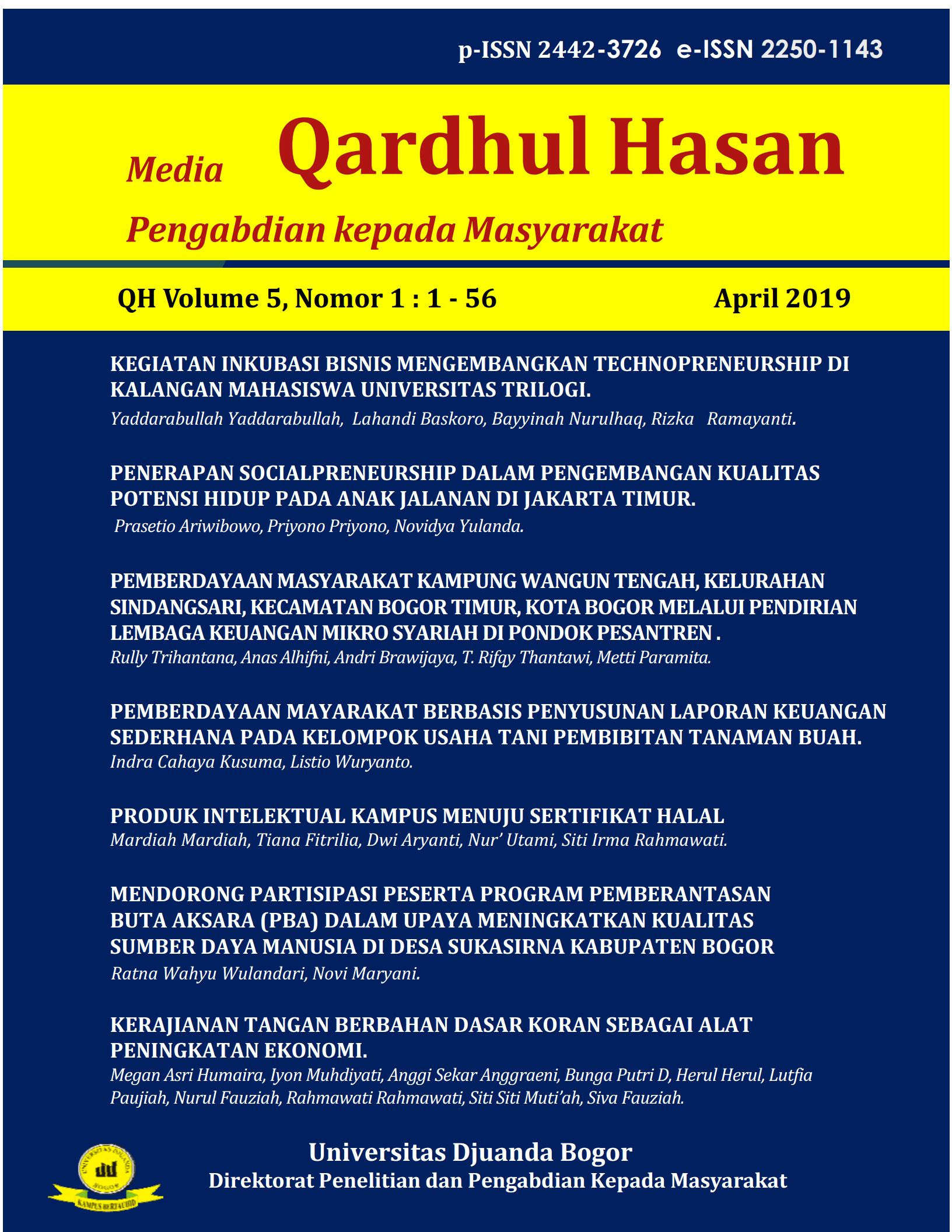COMMUNITY EMPOWERMENT ON UTILIZATIONHUSK WASTE INTO HUSK CHARCOAL BRIQUETTES
DOI:
https://doi.org/10.30997/qh.v8i3.6775Keywords:
alternative energy, biobriquettes, husk charcoal, husk wasteAbstract
The land characteristics of Pemulutan Ilir Village are dominated by swamps, so the people's main agriculture is the cultivation of lowland swamp rice. The existence of extensive rice fields encourages the development of rice milling businesses that produce husk waste. The husk waste has not been utilized by the community. If processed, rice husk waste will become a more useful product, once is husk charcoal briquettes. This community service activity is the implementation of the Community Partnership Program of the Ministry of Education and Culture of the Republic of Indonesia in 2022 which is carried out by the IBA University team. The participants are the community of Pemulutan Ilir Village. Activities start from May-December 2022. Activities are carried out in several stages, starting with surveys and field observations to inventory and analyze partner resources and problems, determine problem solutions, conduct training and mentoring partners to utilize husk waste into charcoal biobriquettes. To the community, there has been a transfer of technological innovation for making husk charcoal briquettes, training and assistance in the process of burning to produce husk charcoal, making adhesive dough, briquette dough and printing briquettes. The result is the peoples of Pemulutan Ilir Village have succeeded in absorbing and being able to carry out all stages for making husk charcoal briquettes and have succeeded in making husk charcoal briquettes that are dense, neat and uniform. The community is very motivated to produce husk charcoal briquettes commercially in order to increase their income and improve the family's economy
References
Abdullahi AB dan ZD Mustaka. 2016. Penerapan konsep zero waste pada usaha penggilingan padi di Kabupaten Pinrang. Prosiding seminar Nasional Hasil Penelitian dan Pengabdian Kepada Masyarakat 2016. Denpasar, 29-30 Agustus 2016. Pp. 420-429
Badan Litbang Pertanian Kementan. 2018. Sekam padi dari limbah jadi bahan bakar alternatif. https://www.litbang.pertanian.go.id/info-teknologi/3219/
Badan Pusat Statistik Ogan Ilir. 2016. Luas panen dan produksi padi menurut kecamatan di Kabupaten Ogan Ilir -2014. https://oganilirkab.bps.go.id/statictable/2016/ 03/21/32/luas-panen-dan-produksi-padi-menurut-kecamatan-di-kabupaten-ogan-ilir-2014.html
Baderan DWK dan MS Hamidun. 2016. Pemanfaatan sekam padi sebagai bahan bakar alternatif dan pupuk organik yang ramah lingkungan di desa lakeya kecamatan tolangohula kabupaten gorontalo. Laporan akhir KKS Pengabdian Universitas Negeri Gorontalo Tahun 2016. 65 hal. https://repository.ung.ac.id/abdi/show/1/385/ pemanfaatan-sekam-padi-sebagai-bahan-bakar-alternatif-dan-pupuk-organik-yang-ramah-lingkungan-di-desa-lakeya-kecamatan-tolangohula-kabupaten-gorontalo.html
Rahmiati F, G Amin dan E German. 2019. Pelatihan pemanfaatan limbah padi menjadi arang sekam untuk menambah pendapatan petani. Jurnal Ilmiah Pengabdian kepada Masyarakat Agrokreatif, 5 (2): 159-164
Sutisna NA, F Rahmiati dan G Amin. 2021. Optimalisasi pemanfaatan sekam padi menjadi briket arang sekam untuk menambah pendapatan petani di Desa Sukamaju, Jawa Barat. Agro-Bali : Agriculture Journal, 4(1) : 116-126
Yuliah Y, S Suryaningsih dan K Ulfi. 2017. Penentuan kadar air hilang dan volatile matter pada bio-briket dari campuran arang
Downloads
Published
How to Cite
Issue
Section
License
Copyright (c) 2022 Novisrayani Kesmayanti Kesmayanti, Bahrul Ilmi Ilmi

This work is licensed under a Creative Commons Attribution-ShareAlike 4.0 International License.
- Copyright on articles is retained by the respective author(s), without restrictions. A non-exclusive license is granted to Qardhul Hasan: Media Pengabdian kepada Masyarakat to publish the article and identify itself as its original publisher, along with the commercial right to include the article in a hardcopy issue for sale to libraries and individuals.
- Articles published in Qardhul Hasan: Media Pengabdian kepada Masyarakat are licensed under a Creative Commons Attribution-ShareAlike 4.0 International license. You are free to copy, transform, or redistribute articles for any lawful purpose in any medium, provided you give appropriate credit to the original author(s) and the journal, link to the license, indicate if changes were made, and redistribute any derivative work under the same license.
- By publishing in Qardhul Hasan: Media Pengabdian kepada Masyarakat, authors grant any third party the right to use their article to the extent provided by the Creative Commons Attribution-ShareAlike 4.0 International license.


